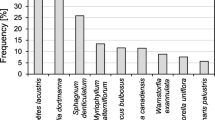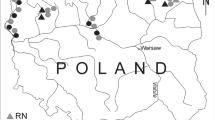Abstract
Phytosociological and habitat studies of the phytocoenoses of Luronium natans have been conducted. The present results were compared with data on L. dortmanna and I. lacustris. It is demonstrated that the community of L. natans differs from the other two communities with respect to habitat conditions despite the fact that they have been reported to occur jointly and alongside in Lobelia lakes. It appears that significant differences between the communities are found not only regarding their waters, but also their substrates. L. natans dominated phytocoenoses are confined to oligotrophic, extremely soft waters, markedly poor in Ca2+, but richer in Na+ and SO4 2- than those of Lobelia and Isoëtes. Luronium natans develops best on acidic, highly hydrated substrates rich in organic matter, NO3 − and total N. The results obtained indicate that L. natans and the phytocoenoses formed by it are characterized by their narrow ecological amplitude in Poland as opposed to those occurring in western Europe, which tolerate a relatively wide range of habitats. The present findings confirm the data from numerous works, which point to the weak competitive ability of the species compared with species typical of eutrophic waters.
Similar content being viewed by others
References
Arts, G. H. P. & R. S. E. W. Lueven, 1988. Floristic changes n shallow soft waters in relation to underlying environmental factors. Freshwater Biol. 20: 97–111.
Arts, G. H. P., G. Van der Velde, J. G. M. Roelofs & C. A. M. Van Swaay, 1990. Successional changes in the soft-water macrophyte vegetation of (sub)atlantic, sandy lowland regions during this century. Freshwat. Biol. 24: 287–294.
Braun-Blanquet, J., 1951. Pflanzensoziologie. 2 Aufl. Springer, Wien: 631 pp.
Dąmbska, I., 1965. Roślinność litoralu jezior lobeliowych Pojezierza Kartuskiego. PTPN, Prace Kom. Biol. 30: 1–53.
Den Hartog, C. & S. Segal, 1964. A new classification of the waterplant communities. Acta Bot. Neerl. 13: 367–393.
Dierßen, K., 1975. Prodromus der eurpäischen Pflanzengesellschaften. Lfg. 2. Littorelletea uniflorae. Vaduz: 149 pp.
Greulich, S., G. C. Bornette, Amoros & J. G. M. Roelofs, 2000. Investigation on fundamental niche of a rare species: an experiment on establishment of Luronium natans. Aquat. Bot. 66: 209–224.
Hach Company, 1992. Hach water analysis handbook. Hach Co. Loveland, Colorado: 831 pp.
Hanspach, D. & H.-D. Krausch, 1987. Zur Verbreitung und Ökologie von Luronium natans (L.) Raf. in der DDR. Limnologica (Berlin) 18: 167–175.
Hermanowicz, W., W. Doÿzańska, J. Dojlido & B. Koziorowski, 1976. Fizyczno-chemiczne badanie wody i ścieków. Arkady, Warszawa: 847 pp.
Klosowski, S., 1994. Ekologia glównych zbiorowisk roś lin wodnych z klasy Littorelletea uniflorae Br.-Bl. Let Tx. 1943 w Polsce. In: Kraska, M. (ed.), Jeziora Lobeliowe. Charakterystyka, funkcjonowanie i ochrona. Cz. I. Idee ekologiczne, Tom 6, Ser. Szkice 4: 93–104.
Kraska, M. & R. Piotrowicz, 1994. Roślinność wybranych jezior lobeliowych na tle warunków fizyczno-chemicznych ich wód. Idee ekologiczne (Szkice) 6, 4: 67–83.
Kraska, M., R. Piotrowicz & P. Klimaszyk, 1996. Jeziora lobeliowe w Polsce. Chrońmy Przyr. Ojcz. 52, 3: 5–25.
Meusel, H., E. Jäger & E Weinert, 1965. Vergleichende Chorologie der zentraleuropäischen Flora. Jena: 583 pp.
Pietsch, W., 1977. Beitrag zur Soziologie und Ökologie der europäischen Littorelletea-und Utricularietea-Gesellschaften. Feddes Repert. 88: 141–245.
Pietsch, W., 1982. Makrophytische Indikatoren für okochemische Beschaffenheit der Gewässer. In Breitig, G. & W. Tumpling (eds), Ausgewahlte Methoden der Wasseruntersuchung. Bd. 2. Gustav Fischer, Jena: 67–88.
Rejewski, R., 1981. Roślinność jezior rejonu Laski w Borach Tucholskich. Rozprawy UMK, Toruń: 1–178.
Roelofs, J. G. M., 1983. Impact of acidification and eutrophication on macrophyte communities in soft waters in the Netherlands. I. Field observations. Aquat. Bot. 17: 139–155.
Roelofs, J. G. M., J. A. A. R. Schuurkes & A. J. M. Smits, 1984. Impact of acidifiation and eutrophication on macrophyte communities in soft wates. II. Experimental studies. Aquat. Bot. 18: 389–411.
Schuurkes, J. A. A. R., M. A. Elbers, J. J. F. Gudden & J. G. M. Roelofs, 1987. Effect of simulated ammonium sulphate and sulphuric acid rain on acidification, water quality and flora of small-scale soft water systems. Aquat. Bot. 28: 199–226.
Sokal, R. R. & F. J. Rohlf, 1995. Biometry: the principles and practice of statistics in biological research. W. H. Freeman and Company, New York: 850 pp.
Schaminée, J. H. J., V. Westhoff & G. H. P. Arts, 1992. Die Strandliggesellschaften (Littorelletea uniflorae Br.-Bl. et Tx. 43) der Niederlande, in europäischen Rahmen gefaßt. Phytocoenologia 20: 529–558.
Szańkowski, M. & S. K;osowski, 1996. Habitat variability of the phytocoenoses of Isoëto-Lobelietum in Poland. Fragm. Flor. Geobot. 41: 255–267.
Szmeja, J., 1993. Luronium natans (L.) Rafin (Elisma natans (L.) Buchenau)-elisma wodna. In Zarzycki, K. & R. Kaźmierczakowa (eds), Polska Czerwona Księga Roślin, Kraków: 197–198.
Szmeja, J. & B. Clément, 1990. Comparison de la structure et du déterminisme des Littorelletea uniflorae en Poméranie (Pologne) et en Bretagne (France). Phytocoenologia 19: 123–148.
Szmeja, J., 1997. Specyfika i zagroÿzenia jezior lobeliowych w Polsce. In Faltynowicz, W., M. Latalowa & J. Szmeja (eds), Dynamika i Ochrona Roślinności Pomorza. BoguckiWyd. Nauk. Gdańsk-Poznań: 83–90.
Ter Braak, C. J. F. & P. Šmilauer, 1998. CANOCO Reference Manual and User's Guide to Canoco for Windows. Software for Canonical Community Ordination (version 4). Centre for Biometry Wageningen (Wageningen, NL) and Microcomputer Power (Ithaca NY, U.S.A.): 352 pp.
Van Katwijk, M. M. & J. G. M. Roelofs, 1988. Vegetaties van waterplanten in relatie tot het milieu. Laboratorium voor Aquatische Oecologie. Katholieke Universiteit Nijmegen, Nijmegen: 133 pp.
Wade, P. M. & S. Greulich, 1998. Luronium natans (L.) Rafin., a rare aquatic plant: an assessment of its status and changes over the last 100 years. Proceedings 10th EWRS Symposium on Aquatic Weeds 1998, Lisbon: 147–150.
Westhoff, V. & A. J. Held den, 1969. Plantengemeenschappen in Nederland. Thieme, Zutphen: 324 pp.
Wilby, N. J. & J. W. Eaton, 1993. The distribution, ecology and conservation of Luronium natans (L.) Raf. in Britain. J. Aquat. Plant Manage. 31: 70–76.
Wittig, R. & R. Pott, 1982. Die Verbreitung von Littorelletea-Arten in der Westfalischen Bucht. Decheniana (Bonn) 135: 14–21.
Author information
Authors and Affiliations
Rights and permissions
About this article
Cite this article
Szańkowski, M., Kłosowski, S. Habitat conditions of the phytocoenoses dominated by Luronium natans (L.) Rafin in Poland. Hydrobiologia 455, 213–222 (2001). https://doi.org/10.1023/A:1011914607379
Issue Date:
DOI: https://doi.org/10.1023/A:1011914607379




